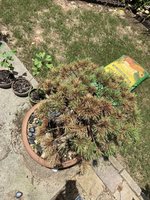Hello,
i have had a healthy pinus mugo bonsai tree for some time now. About 2 months ago I began styling it with wire. It was doing fine.
It got an infestation of millipedes in its pot. I can see them everywhere crawling on the low part of the trunk. I am concerned they are eating the roots of my tree.
about a week ago I noticed the needles turning brown all over: the tree looks to be dying.
I thought the tree was being strangled by the plan that accompanied its tray. When I bought the bonsai tree it had what I believe to be oregano growing out of it. It took over and grew too large. I asked my husband to do so, at which time he found two copper head snakes living inside.
So I don’t know if it’s millepedes, over growth of the neighboring plant, or snakes. What are your thoughts? Here’s photos of the creepy crawly bugs inside.
i have had a healthy pinus mugo bonsai tree for some time now. About 2 months ago I began styling it with wire. It was doing fine.
It got an infestation of millipedes in its pot. I can see them everywhere crawling on the low part of the trunk. I am concerned they are eating the roots of my tree.
about a week ago I noticed the needles turning brown all over: the tree looks to be dying.
I thought the tree was being strangled by the plan that accompanied its tray. When I bought the bonsai tree it had what I believe to be oregano growing out of it. It took over and grew too large. I asked my husband to do so, at which time he found two copper head snakes living inside.
So I don’t know if it’s millepedes, over growth of the neighboring plant, or snakes. What are your thoughts? Here’s photos of the creepy crawly bugs inside.







